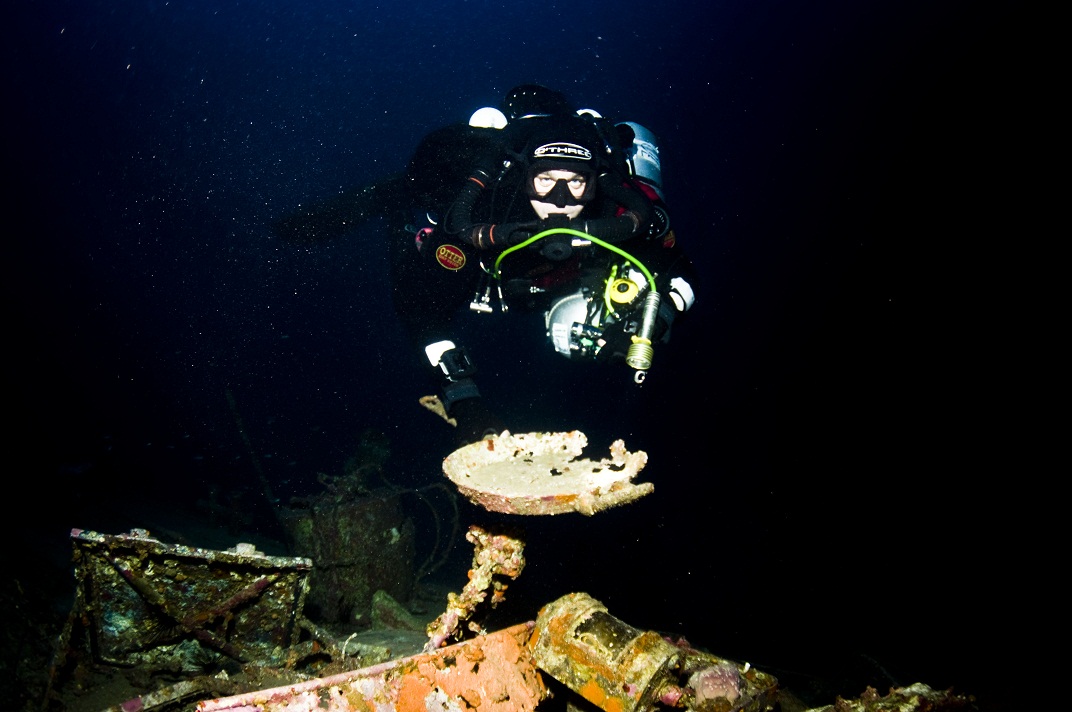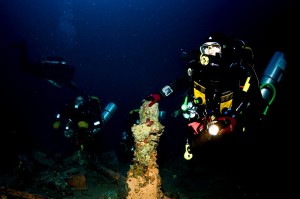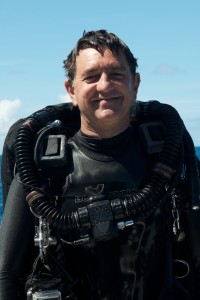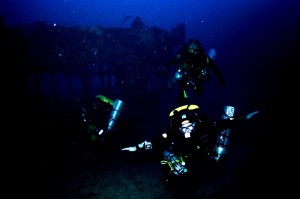News
At 100 metres, no one can hear you scream… but can they hear you sing?

The Mile High Club. Ever heard of it?
The 100 Metre Club. Ever heard of that?
Which one is more risky?
Which one is more achievable, more probable, more plannable?
Well it isn’t the Boeing 747 option with the toilet roll holder stuck up your backside and a pair of tights strangling you and one stray big toe constantly hitting the attendant call button.
Getting to the Big One Hundred takes far more courage and a lot more planning, it’s a hell of a lot less risky and a lot less embarrassing if you get caught doing it. It used to be only deep explorers that went as deep as 100 metres; now 100m divers are high-tec divers, and without diminishing the achievement of planning and executing a dive of this calibre, a little bit more common.
It is still a very exclusive club, one that I would like you all to join. There are no guarantees that you will be able to get there (in terms of your ability), but with the right understanding, desire, training and experience, I do believe that the 100 metre club could be a lot bigger. The funny thing here is that most of the girls reading this article are thinking that it’s a waste of time to read further. Well, in my opinion, you are the future big deep hairy (and I’m not referencing armpits, legs or Brazilians here) tech divers. Girls struggle less with peer pressure, they are calm under fire and most importantly, they breathe a whole lot less gas. More gas means more time. More time means more exploration.
So how exactly do you get there?
In previous articles I have written about choosing the instructor and training agency, also whether you are going to be an Open Circuit or Closed Circuit technical diver. The most important decisions after those are, do you need to go to 100 and why? I don’t believe in just doing a dive to 100 metres for the hell of it, I believe we should have an objective. For me, that usually means a wreck or some beautiful topography, as I’m afraid to say it is not teeming with fish down there. If you will never use the skills learned on this course again, then it seems like a real waste.
Doing the dive
You do not need to dive to 100 on your training course; in fact some agencies do not allow it, however I believe that it is a very good thing to do. My reasoning is empirical really. I have qualified a fair few Trimix divers now, and when a divers depth timer/computer hits triple figures, there is something that changes within that diver, as recounted by Alex Griffin of Diving Leisure London:
 “As a reasonably experienced diver and instructor I find that the most excitement I draw from recreational diving comes from either diving in environments or places substantially different from those I’ve dived before or from seeing the enjoyment in the faces of those that I teach.
“As a reasonably experienced diver and instructor I find that the most excitement I draw from recreational diving comes from either diving in environments or places substantially different from those I’ve dived before or from seeing the enjoyment in the faces of those that I teach.
“In some ways I’ve come to miss that nervous excitement that comes from being on a boat heading out to a dive, knowing that your limits and abilities are about to challenged.
“When I completed my IANTD Trimix course with Diving Matrix in Malta I perfectly re-captured that feeling as I went out to complete my 100m qualifying dive. This is an experience that you know is going to be monumental. I enjoyed the anticipation of knowing I was about to do something I’d never done before, that was a major challenge – but also knowing I was capable of pulling it off.
“The dive itself went without a hitch. The sensation of looking at your computer and seeing 100m on the display is pretty mind boggling. We also had the privilege of completing the dive on a massive unidentified cargo ship and we had a few minutes to explore the bow. That was incredible; to actually be at a 100m and ‘doing a dive’ was, for me, the highlight of the experience. The decompression schedule was surprisingly light and the whole dive took only an hour; I returned to the surface feeling a mix of awe, triumph and extreme happiness.
 “Going back in to harbour I realised that this is why I love scuba diving so much; no matter who you are or how much experience you have, there is always something new to see or do that will keep you feeling just like you did when you first put your head under the water.”
“Going back in to harbour I realised that this is why I love scuba diving so much; no matter who you are or how much experience you have, there is always something new to see or do that will keep you feeling just like you did when you first put your head under the water.”
I believe it is best to experience your first 100 metre dive under the watchful eye of an experienced deep Trimix instructor, so pick your Trimix instructor with as much caution as you chose your entry level instructor… as you are about to turn your world on its head.
What about the training?
The training is actually not that hellish. You will have to go through a series of courses before you get the prerequisites for Full Trimix. I can assure you of one thing, every one of the courses is an absolute blast.
Beginning with Advanced Nitrox (and Deco procedures, depending on agency), which teaches you basic twinset, long hose and stage cylinder management. This course teaches minimal deco and about a 40 odd metre depth maximum.
Next you have an Extended Range (Tec Deep) or Normoxic (breathable at the surface) Trimix. On this course deco is dramatically increased and a max depth of around 60 metres can be achieved.
And finally you are eligible for full blown Trimix. This is an unlimited deco, multi stage 100 metres maximum depth programme (some agencies like DSAT are 75 metres).
 On completion of the dive I do believe that life changes a little. Something in your soul lights up like a little beacon. I felt like I had journeyed to another galaxy like an extreme explorer, and I suppose I did. Not that many people even peer underwater using a mask and snorkel, let alone dive to 100 metres, so I guess I had been to another galaxy. I certainly looked like I was going into space. Sadly, the world’s media were not there to meet me when I surfaced grinning like a Cheshire cat. I was not put into the hall of fame along side Neil Armstrong and Buzz Aldrin, but there is a champagne bottle in my local pub that has 11 ATA (11 atmospheres) printed in silver along it’s side on the top shelf as you walk in the door. All my friends came out to celebrate with me, and for a few fleeting moments I became the explorer I had always dreamed I would be.
On completion of the dive I do believe that life changes a little. Something in your soul lights up like a little beacon. I felt like I had journeyed to another galaxy like an extreme explorer, and I suppose I did. Not that many people even peer underwater using a mask and snorkel, let alone dive to 100 metres, so I guess I had been to another galaxy. I certainly looked like I was going into space. Sadly, the world’s media were not there to meet me when I surfaced grinning like a Cheshire cat. I was not put into the hall of fame along side Neil Armstrong and Buzz Aldrin, but there is a champagne bottle in my local pub that has 11 ATA (11 atmospheres) printed in silver along it’s side on the top shelf as you walk in the door. All my friends came out to celebrate with me, and for a few fleeting moments I became the explorer I had always dreamed I would be.
Become all that you want to be, that’s really all this article is about. If you fancy doing 100 metres then go out and talk to an Instructor and let them help you realise your dreams.
Paul is the Director of Training at RAID. To find out more about the courses that RAID offers, visit www.diveraid.com.
Gear News
Introducing the TR-80, IR-50 and CS-30 Regulators from DYNAMICNORD

Whether you are a beginner or a professional diver – with the three new main regulators from DYNAMICNORD, everyone will find their favourite regulator. They all look super stylish.
Excellent performance with the TR-80
Quality and performance are the be-all and end-all for regulators. It is not for nothing that the TR stands for Tec Reg. The innovative design of the TR-80 guarantees absolute reliability – even in ice-cold waters.

Perfect breathing effort at 0.8 J/l / certified for diving in waters below 10 degrees / structural design made of solid brass for best cold protection / membrane-compensated design with dry seal of the first stage / reduced exhalation effort thanks to optimized exhalation membrane and bubble deflector / adjustable Venturi (dive/predive) and adjustment knob for individual inhalation comfort / innovative design of the front cover prevents free-flow in strong currents or when diving with scooters / design made of sandblasted brass, matt chrome finish / 2 HP and 4 LP outlets / mouthpiece made of high-quality, anti-allergic silicone for maximum comfort.


Amazing underwater adventures with the IR-50
The IR-50 is the top regulator for advanced and experienced divers. Natural breathing is the essence of this regulator.

Ideal breathing effort at 0.8 J/l /certified for diving in waters below 10 degrees / compensated membrane / adjustable venturi (dive/predive) and adjustment knob for individual inhalation comfort/ outlet valve and deflector for minimum exhalation effort and reduction of bubbles on the face / design made of sandblasted brass, matt chrome finish / 2 HP and 4 NP outlets / mouthpiece made of high-quality, anti-allergic silicone for maximum comfort.


The Workhorse – our CS-30
For diving centres and diving beginners – the workhorse stands for strong construction, reliability and robustness. Perfect for your training.

Optimal breathing effort at 0.8 J/l /recommended for diving in waters above 10 degrees / non-compensated piston / adjustable venturi (dive/predive) / outlet valve and deflector for minimum exhalation effort and reduction of bubbles on the face / design made of sandblasted brass, matt chrome finish / 1 HP and 3 NP outlets / mouthpiece made of high-quality, anti-allergic silicone for maximum comfort.


Octopus OP-30
The OP-30 is the ideal addition to all DYNAMICNORD regulators. It is identical in construction to the CS-30.

The TR-80, IR-50, CS-30 (DIN & INT) regulators and the Octopus OP-30 are available from DYNAMICNORD dealers and in the online store.
DYNAMICNORD – Your Outdoor Companion.
Marine Life & Conservation
Paul Watson Released as Denmark Blocks Japan’s Extradition Bid

Renowned anti-whaling activist Paul Watson has been released from custody in Greenland after spending five months in detention. Denmark’s Justice Ministry rejected Japan’s request for his extradition, citing insufficient guarantees that his time already served in custody would be credited against any potential sentence.
The 74-year-old Canadian-American was arrested on July 21 in Nuuk, Greenland’s capital, when his ship docked to refuel. His arrest was based on a 2012 Japanese warrant related to a 2010 encounter in Antarctic waters. Japan alleged Watson obstructed operations and caused damage to a whaling research ship during efforts to disrupt illegal whaling. Watson has consistently denied these claims, maintaining his commitment to marine conservation.
Denmark, which oversees extradition matters for Greenland, concluded that while the legal conditions for extradition were met, the lack of assurances from Japan regarding time-served credit made extradition untenable.
In a video shared by his foundation, Watson expressed gratitude and relief, saying, “After five months, it’s good to be out… and good to know they’re not sending me to Japan.” He added that the most difficult part of his time in custody was being separated from his two young sons.
Watson is a pioneering figure in marine conservation, known for founding the Captain Paul Watson Foundation in 2022 after decades of activism with the Sea Shepherd Conservation Society. His bold efforts to defend marine life have earned him widespread support, including from celebrities and conservationists. His work has also been featured in the acclaimed reality TV series Whale Wars.
Watson’s lawyer, Jonas Christoffersen, praised the decision, stating, “We are happy and relieved that Paul Watson is now free.” He added that Watson is eager to reunite with his family and continue his vital work.
The arrest occurred while Watson’s vessel, the M/Y John Paul DeJoria, was en route to the North Pacific with a team of 26 volunteers to intercept a Japanese whaling ship. His foundation described the arrest as politically motivated and emphasized that Watson’s actions were focused on ending illegal whaling practices.
Japan resumed commercial whaling in 2019 after leaving the International Whaling Commission, asserting that whale meat is a cultural tradition. Conservationists, however, continue to challenge these practices, highlighting their impact on marine ecosystems.
Despite the challenges, Watson remains steadfast in his mission to protect marine life and bring attention to whaling practices. His dedication to ocean conservation has made him a globally respected advocate for the environment.
-

 News2 months ago
News2 months agoIconic SS United States to become the World’s Largest Artificial Reef
-

 News3 months ago
News3 months agoBook Review – 52 Assignments: Underwater Photography
-

 Gear News3 months ago
Gear News3 months agoDYNAMICNORD – New German diving brand enters the British market
-

 News3 months ago
News3 months agoExploring Cenote El Pit: A Diver’s Dream
-

 Gear News3 months ago
Gear News3 months agoTry BARE drysuits (and maybe even win one!) this Friday with Sea & Sea at North West Dive Fest
-

 Marine Life & Conservation3 months ago
Marine Life & Conservation3 months agoBook Review: Coral Triangle Cameos
-

 Blogs2 months ago
Blogs2 months agoDive the Egyptian Red Sea this Autumn with Regaldive
-

 News3 months ago
News3 months ago2024 Ocean Art Underwater Photo Competition Announced

















